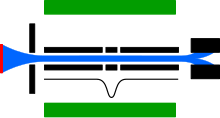
Summary
Electron beam ion trap (EBIT) is an electromagnetic bottle that produces and confines highly charged ions. An EBIT uses an electron beam focused with a powerful magnetic field to ionize atoms to high charge states by successive electron impact.

It was invented by M. Levine and R. Marrs at LLNL and LBNL.[1]
Operation edit
The positive ions produced in the region where the atoms intercept the electron beam are tightly confined in their motion by the strong attraction exerted by the negative charge of the electron beam. Therefore, they orbit around the electron beam, crossing it frequently and giving rise to further collisions and ionization. To restrict the ion motion along the direction of the electron beam axis, trapping electrodes carrying positive voltages with respect to a central electrode are used.
The resulting ion trap can hold ions for many seconds and minutes, and conditions for reaching the highest charge states, up to bare uranium (U92+) can be achieved in this way.[2]
The strong charge needed for radial confinement of the ions requires large electron beam currents of tens up to hundreds of milliampere. At the same time, high voltages (up to 200 kilovolts) are used for accelerating the electrons in order to achieve high charge states of the ions.
To avoid charge reduction of ions by collisions with neutral atoms from which they can capture electrons, the vacuum in the apparatus is usually maintained at UHV levels, with typical pressure values of only 10−12 torr, (~10−10 pascal).
Applications edit
EBITs are used to investigate the fundamental properties of highly charged ions e. g. by photon spectroscopy in particular in the context of relativistic atomic structure theory and quantum electrodynamics (QED). Their suitability to prepare and reproduce in a microscopic volume the conditions of high temperature astrophysical plasmas and magnetic confinement fusion plasmas make them very appropriate research tools. Other fields include the study of their interactions with surfaces and possible applications to microlithography.
References edit
- ^ Levine, Morton A; Marrs, R E; Henderson, J R; Knapp, D A; Schneider, Marilyn B (1 December 1987). "The Electron Beam Ion Trap: A New Instrument for Atomic Physics Measurements". Physica Scripta. T22. IOP Publishing: 157–163. doi:10.1088/0031-8949/1988/t22/024. ISSN 0031-8949. S2CID 250767218.
- ^ Marrs, R. E.; Elliott, S. R.; Knapp, D. A. (27 June 1994). "Production and Trapping of Hydrogenlike and Bare Uranium Ions in an Electron Beam Ion Trap". Physical Review Letters. 72 (26). American Physical Society (APS): 4082–4085. Bibcode:1994PhRvL..72.4082M. doi:10.1103/physrevlett.72.4082. ISSN 0031-9007. PMID 10056377.
- Marrs, Roscoe E.; Beiersdorfer, Peter; Schneider, Dieter (1994). "The Electron‐Beam Ion Trap". Physics Today. 47 (10). AIP Publishing: 27–34. Bibcode:1994PhT....47j..27M. doi:10.1063/1.881419. ISSN 0031-9228.
- Marrs, R. E.; Levine, M. A.; Knapp, D. A.; Henderson, J. R. (25 April 1988). "Measurement of electron-impact–excitation cross sections for very highly charged ions". Physical Review Letters. 60 (17). American Physical Society (APS): 1715–1718. Bibcode:1988PhRvL..60.1715M. doi:10.1103/physrevlett.60.1715. ISSN 0031-9007. PMID 10038121. – First EBIT atomic spectroscopy measurement
- Morgan, C. A.; Serpa, F. G.; Takács, E.; Meyer, E. S.; Gillaspy, J. D.; Sugar, J.; Roberts, J. R.; Brown, C. M.; Feldman, U. (6 March 1995). "Observation of Visible and uv Magnetic Dipole Transitions in Highly Charged Xenon and Barium". Physical Review Letters. 74 (10). American Physical Society (APS): 1716–1719. Bibcode:1995PhRvL..74.1716M. doi:10.1103/physrevlett.74.1716. hdl:1969.1/182526. ISSN 0031-9007. PMID 10057739.
- Cheng, Hai-Ping; Gillaspy, J. D. (15 January 1997). "Nanoscale modification of silicon surfaces via Coulomb explosion". Physical Review B. 55 (4). American Physical Society (APS): 2628–2636. Bibcode:1997PhRvB..55.2628C. doi:10.1103/physrevb.55.2628. ISSN 0163-1829. S2CID 38152493.
- Gillaspy, J. D.; Parks, D.C.; Ratliff, L.P. (1998). "Masked ion beam lithography with highly charged ions". Journal of Vacuum Science & Technology B: Microelectronics and Nanometer Structures. 16 (6). American Vacuum Society: 3294. Bibcode:1998JVSTB..16.3294G. doi:10.1116/1.590367. ISSN 0734-211X.
- Currell, Frederick John; Asada, Junji; Ishii, Koichi; Minoh, Arimichi; Motohashi, Kenji; et al. (15 October 1996). "A New Versatile Electron-Beam Ion Trap". Journal of the Physical Society of Japan. 65 (10). Physical Society of Japan: 3186–3192. Bibcode:1996JPSJ...65.3186C. doi:10.1143/jpsj.65.3186. ISSN 0031-9015.
- Beyer, Heinrich F.; Kluge, H.-Jürgen; Shevelko, Viatcheslav P. (1997). X-Ray Radiation of Highly Charged Ions. Spring Series on Atoms+Plasmas. Vol. 19. Berlin, Heidelberg: Springer Berlin Heidelberg. doi:10.1007/978-3-662-03495-8. ISBN 978-3-642-08323-5.
External links edit
- "EBIT". National Institute of Standards and Technology. 7 December 2010. Retrieved 26 November 2012.
- "Electron Beam Ion Trap (EBIT)". Lawrence Livermore National Laboratory. 14 April 2009. Retrieved 26 November 2012.
- "Other EBITs Around the Globe". National Institute of Standards and Technology. 14 December 2011. Retrieved 26 November 2012.


